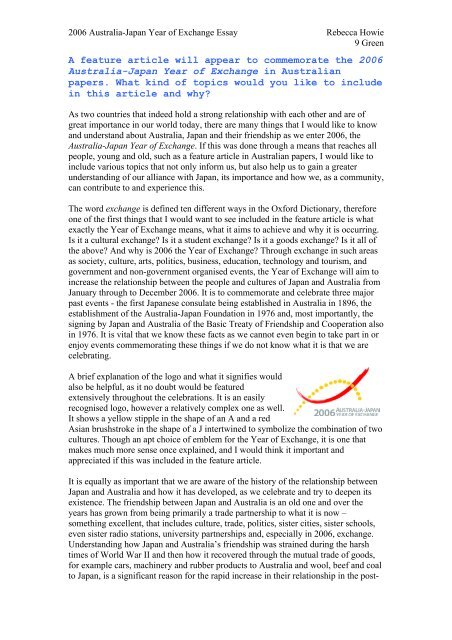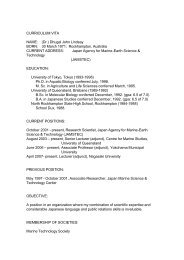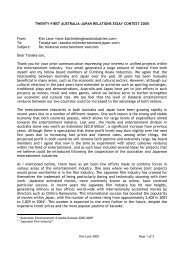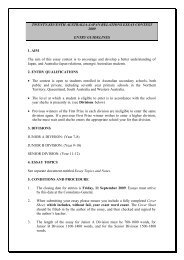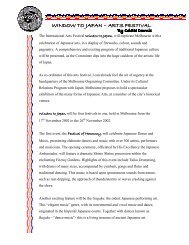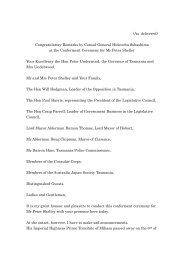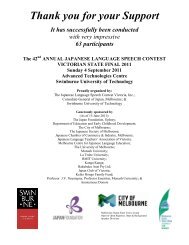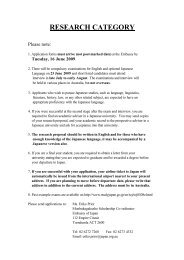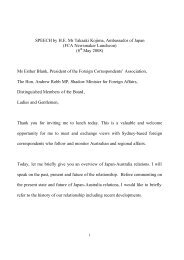Junior B Division Winning Essay
Junior B Division Winning Essay
Junior B Division Winning Essay
You also want an ePaper? Increase the reach of your titles
YUMPU automatically turns print PDFs into web optimized ePapers that Google loves.
2006 Australia-Japan Year of Exchange <strong>Essay</strong> Rebecca Howie<br />
9 Green<br />
A feature article will appear to commemorate the 2006<br />
Australia-Japan Year of Exchange in Australian<br />
papers. What kind of topics would you like to include<br />
in this article and why<br />
As two countries that indeed hold a strong relationship with each other and are of<br />
great importance in our world today, there are many things that I would like to know<br />
and understand about Australia, Japan and their friendship as we enter 2006, the<br />
Australia-Japan Year of Exchange. If this was done through a means that reaches all<br />
people, young and old, such as a feature article in Australian papers, I would like to<br />
include various topics that not only inform us, but also help us to gain a greater<br />
understanding of our alliance with Japan, its importance and how we, as a community,<br />
can contribute to and experience this.<br />
The word exchange is defined ten different ways in the Oxford Dictionary, therefore<br />
one of the first things that I would want to see included in the feature article is what<br />
exactly the Year of Exchange means, what it aims to achieve and why it is occurring.<br />
Is it a cultural exchange Is it a student exchange Is it a goods exchange Is it all of<br />
the above And why is 2006 the Year of Exchange Through exchange in such areas<br />
as society, culture, arts, politics, business, education, technology and tourism, and<br />
government and non-government organised events, the Year of Exchange will aim to<br />
increase the relationship between the people and cultures of Japan and Australia from<br />
January through to December 2006. It is to commemorate and celebrate three major<br />
past events - the first Japanese consulate being established in Australia in 1896, the<br />
establishment of the Australia-Japan Foundation in 1976 and, most importantly, the<br />
signing by Japan and Australia of the Basic Treaty of Friendship and Cooperation also<br />
in 1976. It is vital that we know these facts as we cannot even begin to take part in or<br />
enjoy events commemorating these things if we do not know what it is that we are<br />
celebrating.<br />
A brief explanation of the logo and what it signifies would<br />
also be helpful, as it no doubt would be featured<br />
extensively throughout the celebrations. It is an easily<br />
recognised logo, however a relatively complex one as well.<br />
It shows a yellow stipple in the shape of an A and a red<br />
Asian brushstroke in the shape of a J intertwined to symbolize the combination of two<br />
cultures. Though an apt choice of emblem for the Year of Exchange, it is one that<br />
makes much more sense once explained, and I would think it important and<br />
appreciated if this was included in the feature article.<br />
It is equally as important that we are aware of the history of the relationship between<br />
Japan and Australia and how it has developed, as we celebrate and try to deepen its<br />
existence. The friendship between Japan and Australia is an old one and over the<br />
years has grown from being primarily a trade partnership to what it is now –<br />
something excellent, that includes culture, trade, politics, sister cities, sister schools,<br />
even sister radio stations, university partnerships and, especially in 2006, exchange.<br />
Understanding how Japan and Australia’s friendship was strained during the harsh<br />
times of World War II and then how it recovered through the mutual trade of goods,<br />
for example cars, machinery and rubber products to Australia and wool, beef and coal<br />
to Japan, is a significant reason for the rapid increase in their relationship in the post-
2006 Australia-Japan Year of Exchange <strong>Essay</strong> Rebecca Howie<br />
9 Green<br />
war period. Both countries have bilaterally signed 18 existing agreements and, in the<br />
last 50 years, there have been 10 Japanese prime ministerial visits to Australia and 20<br />
Australian prime ministerial visits to Japan. Whether it be represented by something<br />
as simple as a timeline or as a detailed piece of writing in the feature article, it is a<br />
topic that I would like to include so that we would know where both countries have<br />
been and where they are now, and to help us to commemorate where the friendship<br />
has gone and where it is going.<br />
The events that will take place to celebrate the Australia-Japan Year of Exchange and<br />
how the people of Australia are involved or can get involved are definitely things that<br />
I would like to include in the article. This celebration of exchange of culture is<br />
meaningless if the people of Australia cannot get involved and be part of it, as it is<br />
mostly about the people of each country experiencing the other’s culture; however, if<br />
it was publicised in the feature article, people would find out about the events taking<br />
place and think to take part. These events will include performances of the traditional<br />
music of Japan, collaboration of Australian and Japanese popular music, Japanese<br />
garden creation, bonsai, tea ceremony, cooking and origami presentations, Japanese<br />
martial arts demonstrations, competitions, student study tours, the continuation of the<br />
Australia-Japan Relations <strong>Essay</strong> Contest, exchanges between museums and art<br />
galleries, the celebration of 19 sister city anniversaries, symposiums, forums, tourism<br />
seminars, Japanese technology exhibitions and many more ideas have been proposed.<br />
Already this year, the Japan <strong>Junior</strong> Golf Club of Sydney has hosted an Australia-<br />
Japan Friendship <strong>Junior</strong> Golf Championship in light of next year’s celebrations and to<br />
“…celebrate the relationship between Australia and Japan since WWII and to<br />
promote junior sport between Australia and Japan.” (http://www.pga.org.au/default.as<br />
pxs=juniorseventdisplay&eid=1102) Every person in Australia can take part and<br />
they have a whole year to do so – although, they must be informed of the events<br />
before this can occur.<br />
On the other hand, I would not only like to include what events are proceeding in<br />
Australia, but also what events will take place in Japan. This is a celebration of the<br />
friendship and cooperation of two nations, not just one, and I, along with the people of<br />
Australia, would like to know that this is not just a unilateral commemoration. This<br />
would also provide us with an insight into their culture and how they will celebrate<br />
this anniversary of the Basic Treaty of Friendship and Cooperation differently to us.<br />
Finally, there are some important questions that I believe should be answered in the<br />
feature article – why should this be commemorated, why should we bother, and why<br />
is it important that we do We are a curious generation and we do appreciate<br />
responses to the questions that can sometimes be very complicated and difficult to<br />
answer; however, such questions help us to understand our world today and, in this<br />
situation, understand why international relations are of such value and importance, not<br />
just politically, but also culturally and socially. Trade is, of course, one of the most<br />
crucial points of Australia-Japan relations, although, so too is the impact both<br />
countries have had on the other’s society, culture, people and way of life. This<br />
exchange is what helps our nations to grow and is why we should commemorate<br />
something as crucial as the signing of the Basic Treaty of Friendship and Cooperation<br />
– this should and would need to be explained in the article for the benefit of each and<br />
every one of the people in Australia who asks these questions.
2006 Australia-Japan Year of Exchange <strong>Essay</strong> Rebecca Howie<br />
9 Green<br />
Knowledge is power, and here, the knowledge we would gain from these topics being<br />
included in a feature article to commemorate the Australia-Japan Year of Exchange<br />
would give us great power - to not only understand the relationship and friendship<br />
between Japan and Australia and each other’s culture, but ultimately the power to<br />
enjoy and get involved, as only the people can truly make it a celebration.<br />
Exact Word Count: 1,231 Words<br />
Bibliography:<br />
- Logo Unveiled (2005) [Internet] Available:<br />
http://www.japan.org.au/Logo%20Launch.htm (13/8/2005)<br />
- Downer, Alexander (1997). ‘Natural Partners’ – Australia and Japan: Past,<br />
Present and Future [Internet] Available:<br />
http://www.dfat.gov.au/media/speeches/foreign/1997/downer_ajrs.html<br />
(13/08/2005)<br />
- Japan-Australia Relations (2005) [Internet] Available:<br />
http://www.mofa.go.jp/region/asia-paci/australia/ (13/08/2005)<br />
- Australia-Japan Friendship <strong>Junior</strong> Golf Championship (2005) [Internet]<br />
Available:<br />
http://www.pga.org.au/default.aspxs=juniorseventdisplay&eid=1102<br />
(13/08/2005)<br />
- Japan Country Brief – May 2005 (2005) [Internet] Available:<br />
http://www.dfat.gov.au/geo/japan/japan_brief_bilateral.html (13/08/2005)<br />
- Seeking Ideas and Proposals for the 2006 YOE (2005) Available:<br />
http://www.japan.org.au/Ideas_&_Proposals.htm (14/08/2005)<br />
- 2006 Australia-Japan Year of Exchange (2005) Available:<br />
http://www.japan.org.au/2006_Exchange_Year.htm (13/08/2005)


